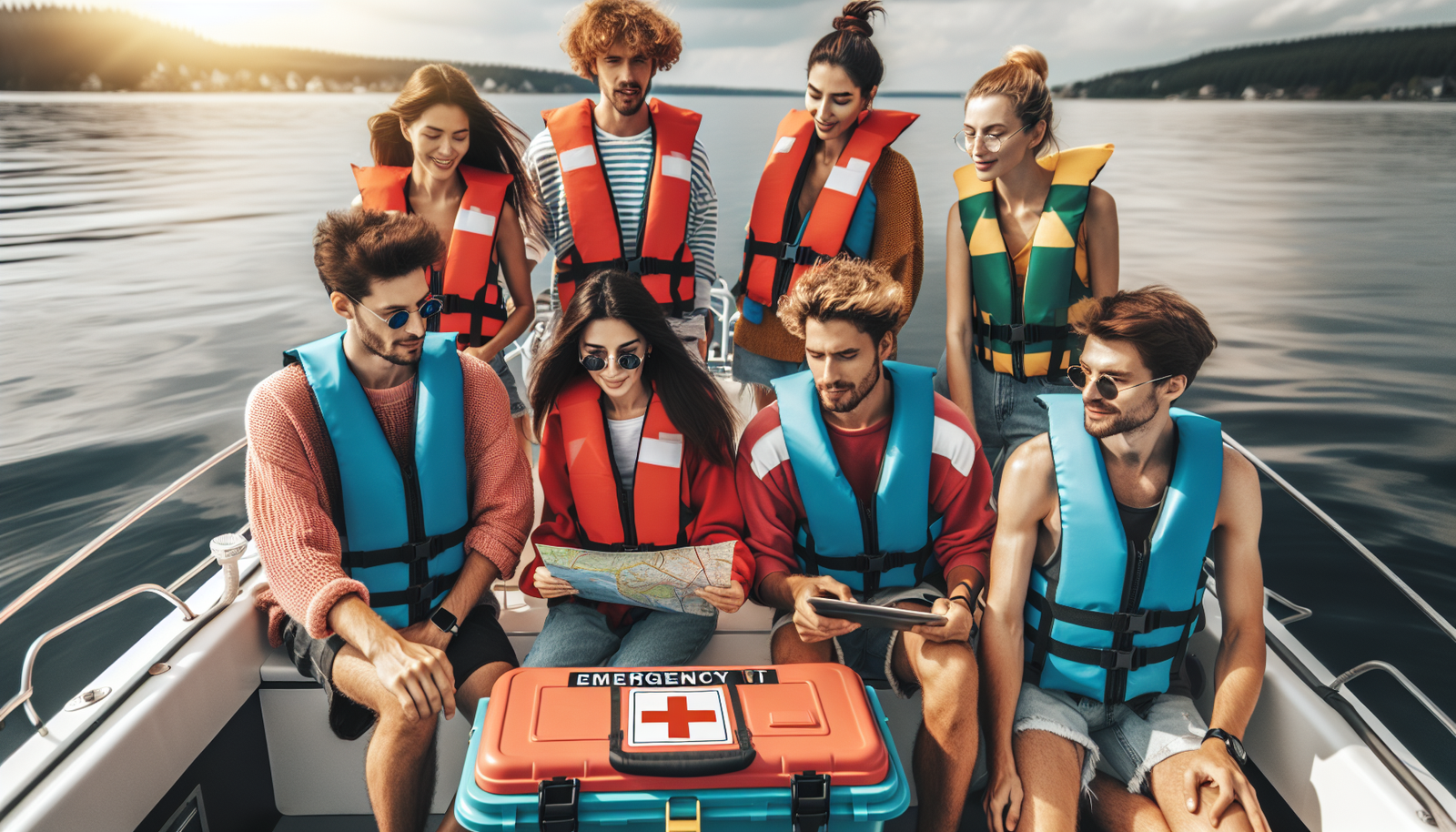Every sea adventurer will find themselves longing to share the enchanting beauty of the waters with others at some point, sparking the planning of a group outing. “Boating Safety Tips For Group Outings” imbues you with knowledge to sail safely, ensuring your adventure becomes a sun-soaked memory, not a perilous mishap. Your journey on nautical safety starts here with information that could not only save your trip, but quite possibly, lives as well.

Understanding the Importance of a Boat Safety Plan
Casting off into the undulating embrace of the sea or river, with a clear sky mirroring the azure depths below, can be both thrilling and soothing. However, the aqua realm can be unpredictable and will not spare a second thought before turning into a tempestuous monster. Your salvation against such capriciousness lies in a well-designed Boat Safety Plan.
The role of a safety plan
A Safety Plan serves as a beacon of guidance in the foggy uncertainties of the water. It prepares you and your crew for potential emergencies and ensures everyone is equipped to handle sudden crises. A lack of preparedness can turn a minor issue into a major disaster. Therefore, a comprehensive safety plan is not an option, but an imperative.
Key elements for your boat safety plan
A solid foundation for your safety plan includes a robust inventory of safety equipment, clear communication channels, knowledge of the vessel’s characteristics, and the assigned roles and responsibilities of each crew member. From life jackets to flares, from evacuation procedures to first aid training, every element should be studied, stocked, and shared.
Ensuring everyone on board understands the safety plan
The strength of the safety plan lies in its universality aboard the vessel. Each crew member or passenger should be made aware of the safety procedures, the location, and use of safety equipment. Practice drills, demonstrations, briefings can help ensure everyone understands and can execute the plan when needed.
Pre-boarding Instructions
Before you succumb to the siren call of the open waters, it is crucial that you’ve mastered the understanding of your vessel.
Introducing the vessel
Every vessel has its own unique story to tell. Its length, its breadth, its capacity, its equipment, and its unique quirks — all of it must be known before you can truly command her on the waves. A thorough inspection and familiarization with every nook and corner of the vessel can significantly uplift your control in challenging situations.
Emergency equipment briefing
Knowing about your emergency equipment is as valuable as your main sails. Regular equipment audits should be conducted to assess their condition, and each member should be given a detailed briefing on the function and operation of the safety equipment.
Explaining everyone’s roles and responsibilities
The spirit and efficiency of a ship’s crew reflect in the vessel’s smooth sailing. By assigning roles and clarifying responsibilities to each participant, you can ensure a well-oiled team that works in harmony to face any wild waves or winds.
Correct Equipment Preparation
The capricious sea respects only one thing — preparedness. Thus, ensuring that the right safety equipment is in place is crucial.
Proper life jackets for each passenger
Life jackets can be the difference between life and death in an emergency situation. Ensure there’s a correct-sized life jacket for each passenger on board and instruct all passengers about how to use them correctly.
Availability of first aid kit
Accidents can occur in the blink of an eye. A comprehensive first aid kit serves as a temporary but immediate solution to any such mishaps. Equip it with bandages, antiseptics, pain-relievers, necessary medication, and the knowledge to employ them correctly.
Ensuring good condition of the communication tools
Being stranded alone in water can be a nightmare. Make sure to have functioning communication tools like a VHF Radio, cellular phone and chargers, or Satellite communicator well-maintained and easily accessible.

Alcohol and Drug Use
Just as fuel keeps the boat running, sound judgment keeps safety afloat.
Dangers of drug and alcohol use in boating
The ingestion of alcohol or drugs severely affects one’s ability to make sound judgments. Under their influence, passengers may ignore safety instructions, misjudge distances, become reckless or, worse, fall overboard unnoticed.
Implementing a no tolerance policy
A zero-tolerance policy against the use of intoxicants, irrespective of the age of passengers, can keep you safe from the danger that lies not only in the depth of seas but above it as well. Remember, safety first, always.
Safety procedures in suspected intoxication scenarios
In unpleasant circumstances, where suspected intoxication occurs, the immediate priority must be protecting all passengers from harm. Procedures might include isolating the intoxicated person, seeking medical attention if required, or returning to shore promptly.
Weather Conditions and Safety
The mercurial moods of Mother Nature can add an unexpected twist to your aquatic adventure.
Monitoring weather conditions before and during the outing
Advanced planning and constant vigilance can help you avoid being caught in the midst of a storm. Monitor weather forecasts and conditions at all times, and be ready to change your plans or route based on weather predictions.
How to respond to sudden changes in weather
In case weather conditions change rapidly, all crew and passengers should be informed and guided to their respective safe positions. Use your communication tools to inform the coast guard or another boat nearby about the situation.
Understanding the impact of weather on the water
Weather conditions can change the behavior of water, creating unpredictable waves and currents. A good understanding of the impact of weather conditions on water movement can go a long way in ensuring safety.
Knowing and Respecting Boating Laws
Navigating the labyrinth of boating laws is as important as navigating the boat itself.
Importance of understanding boating laws
Boating laws are designed to ensure safe and responsible use of waterways. Ignorance or flouting boating laws can lead to accidents or penalties and fines.
Consequences of not following these laws
Not abiding by the laws and regulations can lead to heavy penalties, including the suspension of your boating license. In some cases, it can also result in personal liability or criminal charges in case of an accident.
Educating passengers about boating laws
A brief overview of relevant boating laws should be provided to the passengers, enabling them to understand their responsibilities and enhancing their safety behavior.
Emergency Drills and Procedures
“Practice makes perfect” is a saying older than most ships but remains relevant.
Importance of routine emergency drills
Regular drills and practice of safety procedures can increase the efficiency of the response during real emergencies. It helps develop muscle memory, ensuring quick and effective implementation when needed.
Practical demonstrations of man overboard procedures
Conducting practical demonstrations of ‘man overboard’ procedure allows everyone on board to experience how to react, alert the crew, and initiate rescue operations.
Fire safety drills and procedures
Fire can be a significant threat on a vessel. Make sure applicable fire safety measures are in place, and ensure everyone onboard knows how to operate fire-fighting equipment and what to do in case of a fire.
Underlining Key Navigation Rules
To rule the waves, you must navigate your vessel within the boundaries of defined rules.
Right of way rules
Understanding right-of-way rules can aid in avoiding collision scenarios. This includes knowing when your vessel has the right of way and when it should yield.
Understanding navigational signage and markers
Navigational signage and markers are crucial to safely navigate waterways. These signs provide important information such as the depth of water, hazards, or restricted areas.
Avoiding collisions
Awareness of the water around you, consistent use of navigational tools, and strict adherence to boating laws can help avoid collision scenarios.
Safe Anchoring Practices
Anchoring is not merely about tossing the anchor overboard, but rather, a safe harbor amidst the open water.
Correct anchor usage
Understanding the right techniques of anchoring, including choosing the right spot, setting the anchor, checking its ‘set’, and the correct way to weigh anchor, is crucial for safe anchoring practices.
Safety precautions to consider
Make sure the anchor line is securely tied to your vessel and that the anchor is fully stored and secured before moving. Also, ensure that your anchor is suitable for the bed condition (sandy, rocky, or muddy).
Anchoring in different weather and water conditions
Follow different anchoring techniques and precautions based on the weather and water conditions. Learning about multiple methods of anchoring can be beneficial in changing weather and challenging conditions.
Post-tour Debrief and Reviewing Safety Practices
With the chants of the sea still ringing in your ear, it’s time to reflect on the outing and the safety practices.
Revisiting and discussing observed safety practices
Discussing what safety measures were used, what worked, and what need improvement, is an efficient way to learn from the outing and ensure enhanced safety procedures in the future.
Addressing any safety concerns or issues from the outing
When discussing the outing, be sure to address any safety-related incidents or concerns. Use these moments not to blame, but to learn and plan better for future outings.
Improving safety measures for future outings
Every outing is a new experience and a stepping stone towards enhanced safety measures. Implementing the lessons learned from each trip can ensure safer sailings ahead.
In concluding, remember, your safety and the safety of passengers and crew should always be your first and last thought when sailing. Happy and safe boating to all!

